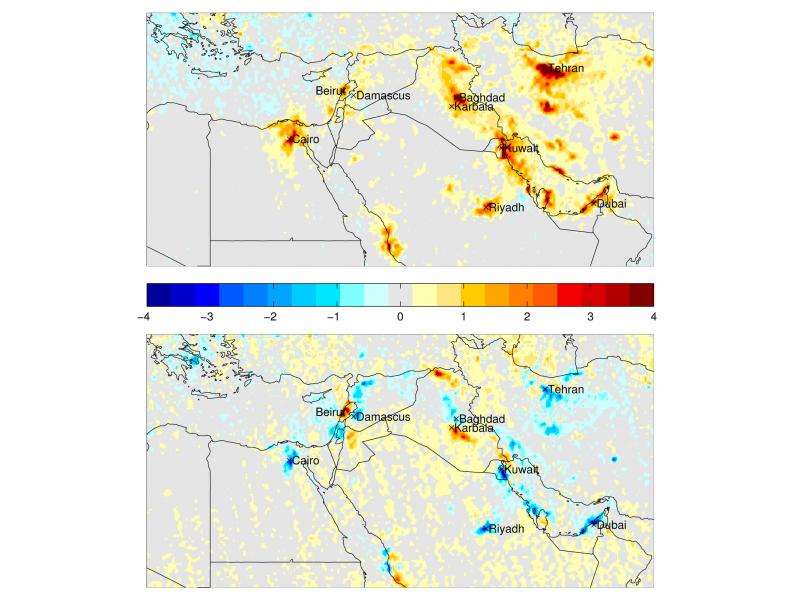August 24, 2015 report
Air pollution decline in Middle East attributed to turmoil and unrest

(Phys.org)—A team of researchers from institutions in Germany and Saudi Arabia has found that pollution levels over several major cities in the Middle East are dropping and have concluded that it is due to economic and political unrest and war. In their paper published in the journal Science Advances, the team describes how they compared satellite data with historical records to show that harsh conditions in some parts of the Middle East have led to less pollution being emitted into the air.
Under normal circumstances, as countries advance, the amount of pollution they emit increases—this was seen in the Middle East, the authors note, in the years after satellite monitoring began in the mid 1990's. Levels of nitrogen dioxide rose as the number of cars on the road increased, and as more electricity was produced by coal fired power plants. But, they note, things changed, starting around 2010—the period during what came to be known as the Arab Spring. Governments were overthrown and in some cases, chaos ensued. That chaos led to a lowering of economic standards in many Middle Eastern cities, which meant less fuel was being burned by cars or used in electricity production. Some cities have seen declines of 20 to 50 percent, though the researchers note that in some cases, the declines are due to legislation put in place to reduce pollution.
Cities seeing the most change tended to be in areas of severe upheaval, the team notes, such as those in Iraq and Syria, where civil war and insurgencies have driven down economic output, and lessened the amount of driving in cars and use of electricity. Notably, the team saw that over the same period, pollution levels in Lebanon actually rose 20 to 30 percent, due they believe, to refugees pouring into the country from nearby Syria. Another example of migration impacting pollution levels, the team notes, is over parts of Bagdad, where the Islamic State has been active—pollution levels have been falling, but rising in nearby safer places. More stable but still experiencing problems was Tehran, suffering under the impact of economic sanctions meant to stop its nuclear ambitions—that city has also been seeing pollution levels falls. Drops in levels in the United Arab Emirates, Kuwait and Saudi Arabia, on the other hand, were attributed to controls put in place to specifically reduce pollution.
More information: "Abrupt recent trend changes in atmospheric nitrogen dioxide over the Middle East." Science Advances 21 Aug 2015: DOI: 10.1126/sciadv.1500498
Abstract
Nitrogen oxides, released from fossil fuel use and other combustion processes, affect air quality and climate. From the mid-1990s onward, nitrogen dioxide (NO2) has been monitored from space, and since 2004 with relatively high spatial resolution by the Ozone Monitoring Instrument. Strong upward NO2 trends have been observed over South and East Asia and the Middle East, in particular over major cities. We show, however, that a combination of air quality control and political factors, including economical crisis and armed conflict, has drastically altered the emission landscape of nitrogen oxides in the Middle East. Large changes, including trend reversals, have occurred since about 2010 that could not have been predicted and therefore are at odds with emission scenarios used in projections of air pollution and climate change in the early 21st century.
Journal information: Science Advances
© 2015 Phys.org


















